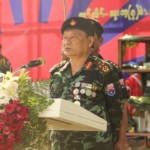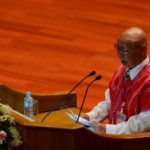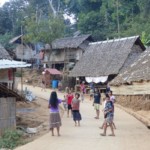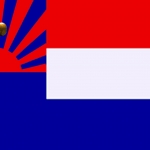Karen Times | July 7, 2016
On June 17, a battalion commander from the Democratic Karen Benevolent Army and twenty of his troops left their base and reunited with the Karen National Liberation Army, the military wing of the Karen National Union.
It was the first high profile reunification between the KNLA and the DKBA soldiers in many years. Hearing the news, Karen communities around the world expressed their joy and praise for this show of unity among the Karen armed groups.
Mathematically and militarily speaking, twenty one soldiers is not a significant number to make a big difference and add to the strength of the Karen National Liberation Army. But politically and psychologically, it is a major boost to the morale of the Karen freedom fighters and Karen community who have long been longing for unity among the Karen armed groups.
The reunification could also encourage other leaders and rank and file soldiers from the breakaway Karen armed groups to follow suit and reunite with the KNLA. It also shows that splinter Karen armed groups have the desire and ability to work together and reunite as one.
However, an important but still unanswered question for many Karen people is that, after all these years and several attempts at reunification, why have the Karen armed groups not been able to reunite and work together in the interest of the Karen people and the Karen community? In other words, what is still holding them up from reuniting and working together instead of working separately to achieve and realize the desire of the Karen people?
Since its 15th Congress, the KNU makes unity and reunification among the splinter Karen armed groups one of its major policy objectives. The signing of the Nationwide Ceasefire Agreement with the government makes it easier for the Karen armed groups to hold meetings and discuss unity and cooperation with less restriction and scrutiny from the government.
Since 2012, more than ten unity and unification meetings and consultations have been held among the Karen armed groups. But so far the meetings have produced little and mixed results. After each meeting, all leaders of the Karen armed groups agreed to work together for the common good of the Karen people. But they always stopped short of declaring unification other than stating that regular meeting will be held to improve communication and cooperation. In the meantime, they continue to bear arms and work separately.
To understand the impediment to and the reasons why reunification among the Karen armed groups have yet to be achieved despite numerous meetings and consultations among the leadership of the Karen armed groups, it is important to look at three things and understand why they might have hold up and undermined unification among the various Karen armed factions.
First, it is still not clear how much commitment do leaders of the splinter Karen armed groups have to reunification although they have plenty of opportunities to do so at present. Publicly, they have all stated that unity is important and crucially needed in the Karen struggle for political autonomy. But privately, according to insider sources, many senior leaders in the DKBA and the Peace Council do not have strong desire and willingness to reunite with the KNU. In this regard, personal interest is a major driving force.
As one KNLA officer who is a member of the unity committee for Karen armed groups put it, “From my point of view, some senior leaders in the breakaway Karen armed groups are still concerned about their privileges and power if they reunite with the KNU. Because of this, they are still very reluctant to reunite with their mother organization.”
This is understandable from a political and economic power point of view. Operating separately allows some of the self-serving leaders and ambitious individuals in the breakaway Karen armed groups to wield political and economic power in areas under their control. One example is that in many local Karen communities along the border, local people have to pay taxes or “gifts” to multiple Karen armed groups such as KNU, DKBA, the Peace Council, and the BGF.
But in some areas, groups such as DKBA and the Peace Council have no active troops beside a handful of men to run business and collect tax from local people. For many local Karen community leaders, groups such as the DKBA and the Peace Council are now nothing but self-serving groups with no clear political objective and direction.
In other words, some of these leaders are individuals with little political ideology other than wanting to be in the armed movement and cultivate personal power and influence. Currently the Peace Council has no more than five hundred troops and they are mostly based in their headquarters Tok Kaw Koe Village. But when it comes to tax collection and business activities, they are present throughout the Brigade 7th.
The reactivation of the Democratic Karen Buddhist Army led by General Kyaw Thet and Col. San Aung following their ouster from the main DKBA group in 2015 is another indication of many senior leaders in the splinter Karen armed groups do not have real commitment and desire to reunite with the KNU. According to some insider sources, KNLA had provided military assistance to the breakaway DKBA faction and their leaders during their clashes with the government and BGF troops in 2015 in the hope that they would reunite with the KNLA.
Gen. Baw Kyaw Heh, the deputy commander-in-chief of the KNLA, reportedly offered to support and welcome back the breakaway DKBA faction into the KNLA. But for unknown reason, despite being chased by the government troops and outcast by their leaders and organization, Col. Kyaw Thet and Col. San Aung did not see the need to reunite with the KNLA.
Although being sheltered and supported by the KNLA for a period of time, they instead regrouped and reactivated the former DKBA Buddhist faction in order to keep their activities alive. As a result, this has frustrated and upset some senior leaders in the KNLA and made them more cautious when it comes to pursuing reunification with the DKBA and other splinter Karen groups. .
Second, unity and cohesion is hard to come by within the breakaway Karen armed groups themselves. As a result, this complicates and poses challenges for the unity committee for Karen armed group’s effort to unify them. Although few in numbers, there are no shortages of personal conflicts and competition for influence within the DKBA and the Peace Council.
In 2014, the late DKBA leader Gen. Saw Lah Pwe issued a statement kicking Col. San Aung out of the group after the later refused to obey an order to report to their headquarters following a skirmish with the government forces. But a few months later, in a sign of leadership challenge, Col. Kyaw Thet brought Col. San Aung back into his battalion without the approval of Gen. Saw Lah Pwe. Many in the Karen community interpreted this as a rising sign of disagreement within the DKBA.
In August 2015, after several deadly clashes between the government forces and the DKBA faction under Col. Kyaw Thet and Col. San Aung on the Asia Highway, the two colonels and their entire battalion were fired and kicked out of the main DKBA group by Gen. Saw Lah Pwe in what many Karen seen as an attempt by the DKBA supreme leader to appease the government and the Burma Army in order to maintain good relations during the peace process.
Like the DKBA, the Peace Council led by Gen. Htay Maung did not fare any better either when it comes to internal unity and organizational cohesion. In 2014, the group also kicked out some ambitious and outspoken leaders within it ranks after they challenge the organization’s leadership and began to act independently, particularly in matter regarding the group business interests and activities.
According to insider sources and some former members of the Peace Council, the group’s leadership often clashed over economic and political issues. While some of the senior leaders prefer to focus on doing business, others focus on demanding more political rights for local Karen community. One of the group’s senior leaders and co-founders, Pastor Timothy, resigned from the Peace Council in 2014 after having a personal and “ideological” conflict with other senior leaders within the group. Since then, he continues to bash and criticize his former organization and some leaders in the group for prioritizing personal interests over community interests.
Finally, despite making reunification one of its policy objectives, the KNU under the leadership of Gen. Mutu Say Poe seems to prioritize peace with the government and push unification effort to the background. According to sources inside the KNU, lackluster support from the senior leaders has undermined negotiations with the breakaway Karen armed groups.
In 2014, representatives from the DKBA, KNU, and the Peace Council converged on Kaw Thoo Mwei Kee, the headquarters of the DKBA, to discuss the formation of Kaw Thoo Lei Armed Forces or KAF. It was an effort led by junior leaders from the three Karen armed groups to form close cooperation and found a united front. It was also in response to the rising government troops activities in the Karen State.
But the meeting and the initiative was thwarted by some senior leaders within the KNU because they worried that it might complicate and affect ongoing peace talks with the government. Instead of sending senior political and military leaders to the meeting, the KNU sent only a few junior officers with no decision-making power. Instead of declaring support for the KAF, some senior leaders within the KNU discouraged KNLA officers from joining the group. According to a local Karen activist, Gen. Mutu Say Poe and many of his close associates had even threatened to sack Gen. Ner Dah Mya and Gen. Baw Kyaw Heh for signing the declaration statement on the formation of the KAF.
Some senior and junior leaders from the DKBA and the Peace Council would love to see the KNU leads the KAF. But they were disappointed at the lack of support and leadership from the KNU during this crucial time. As a result, the declaration of KAF was meaningless. Many Karen activists and local community leaders see a lack of KNU support for the KAF as a loss opportunity for unification of the Karen armed groups.
This article originally appeared on Karen Times on July 7, 2016.







